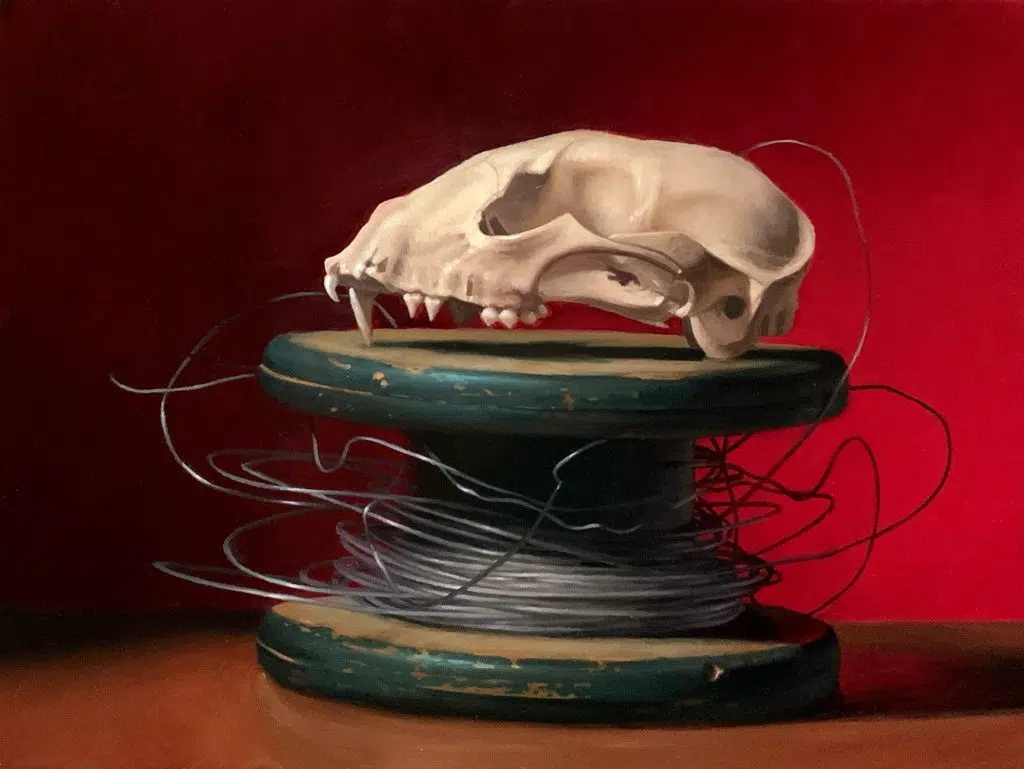
David Carpenter near his home in Manitowoc
The following article is written for the Rahr-West Art Museum Art Forward series by Diana Bolander, Assistant Director/Curator.
A new exhibit at the Rahr-West Art Museum revolves around a cabinet commissioned by the Museum of Wisconsin Art that was created with contributions by carpenter Randy Sahli, woodcarver Patrick Burke, and painter David Carpenter. Carpenter, a Manitowoc artist and educator, features his extraordinarily realistic still-life oil paintings in the project.
Carpenter has lived in Manitowoc the last ten years though he grew up in New Haven, Indiana, and later earned his Master of Fine Arts at the New York Academy of Art. Carpenter currently teaches drawing and painting at the University of Wisconsin-Whitewater in addition to St. Norbert College and was happy to return to the affordable housing and open spaces of the Midwest. He likes teaching and sees art as a form of problem-solving, stressing the importance of tools like the value sphere with his figure drawing students. Carpenter says in another life he would probably be a wallpaper designer because of his love of pattern, grids, and structure. His practice is firmly grounded in physicality and representation rather than romantic notions about creativity and process. Indeed, his mother-in-law was disappointed to find he didn’t paint while listening to classical music surrounded by scented candles, Carpenter jokes. He’s much more likely to paint in his pajamas with reruns of Frasier playing in the background and doesn’t exhibit the manic impulsiveness or deep “angst” prevalent in pop-culture’s stereotypes of artists.
He sees himself as more of a craftsman than an Artist; so much so that it can influence his choice of subjects. For example, Carpenter is drawn to tools as subject matter and conveniently they are readily available at the Hamilton Woodtype Museum in Two Rivers where his wife works and creates. Carpenter has recently trended towards pairs of disparate objects that don’t necessarily make natural pairs, like bone and metal. Bone is organic in nature and the metal represents something manufactured. These dichotomies tend to appear as he creates and the ideas evolve. When he begins new work, he usually begins by abstractly arranging shapes, drawn to objects for their size and shape. Carpenter does most of his oil paintings on Masonite panels and prefers the smooth rigid surface of the panels to canvas.

David Carpenter, Skull with Wire, Oil on panel
Despite his dedication to traditional still-life paintings like the ones in the Rahr-West exhibit, Carpenter embraces technology and uses digital drawing programs like Procreate and Adobe Fresco as sketchbooks. He finds these digital formats allow safe and quick ways to try different techniques. There are no wasted materials or consequences, it is just time spent on art.
Carpenter excels in a number of different styles and media by necessity, as he is, in his words, a commodity. This mindset affords his clients more options. He enjoys working within the constraints imposed by clients in commissions. Instead of being confining, commissions evoke greater creativity. A recent project during the pandemic found Carpenter create a series of family images inspired by different cartoons, such as Rick and Morty, Batman, The Simpsons, and Aeon Flux. What started as a side-project as he watched TV in the evening morphed into an invaluable exercise he included in his drawing classes. Art and life inform each other.
Carpenter’s murals can be seen inside the entrance of the Manitowoc Public Library (the storybook mural) and the new typographic mural at Pinecrest Village. Those interested can see many examples of paintings and sketches @david.carpenter on Instagram. The Manitowoc/MOWA Cabinet exhibit will be on display through September 5, 2021 at the Rahr-West Art Museum in Manitowoc.












